|
02/20/2018 10:28AM |
Spent about 15 minutes only in the Advantage,, still looking for a name, and initial impression is quite a bit more twitchy than my Magic, and significantly less secondary stability. The Magic seemed to get more and more stable the more it was leaned. The Advantage seemed to be ready to tip quicker and I thought at least twice is was going over. It was a windy day, actually blew the canoe up the beach when unattended, with good chop. I was pleased with the way it handled the wind, I did not get blown about much at all. It is also a wetter ride than the Magic. It also appears faster and tracks really well. Again this was only a very brief ride.
While the numbers of both canoes are very similar the shape of the canoes are quite different. The Magic has much more volume in the bow and stern. The numbers don't really catch the how skinny the Advantage is forward and rearward of center. The width of each canoe is the same but that is only at the widest point which is much more centered in the Advantage. It has more of a diamond shape. I'm excited to get it on the Missouri River, but pretty sure I will be swimming.
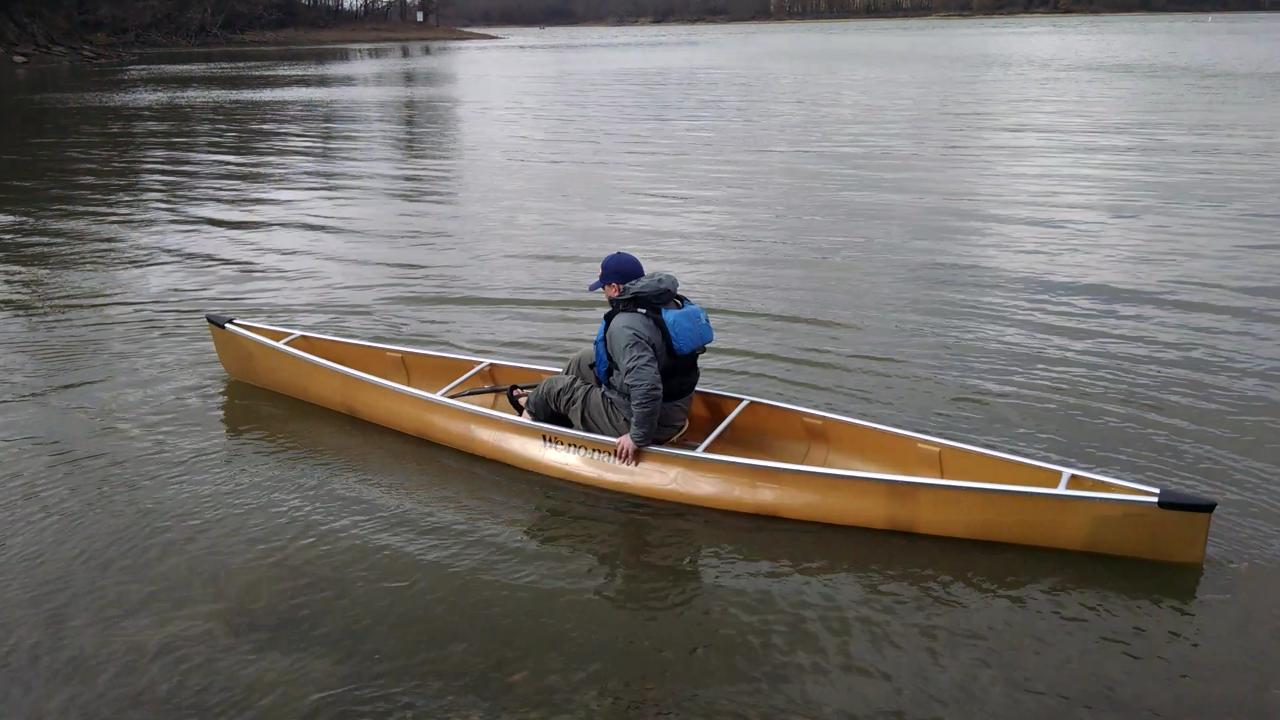
|
01/27/2018 10:33AM |
Alan Gage: "Rivermagic: "Yes from all accounts it appears the Advantage is some faster than the Magic, so my question is to what is this attributed to given the specs are so similar especially given the thinner waterline of the Magic. I realize this is about hull design and trying to learn and make sense of it. Looking at the numbers clearly does not tell the whole story."
I like to build canoes and the last half dozen I've designed myself. The software allows me to calculate how much resistance a hull has as it moves through the water. I won't say I understand the nuances of hull design but I've played around a lot and have been tickled pink with every boat I've designed. One thing I've stopped doing is trying to compare manufacturer specs and extrapolate how fast a canoe will be. There are so many small variables that all add up to make a small difference that it's impossible to point to one thing.
It's also shown me just how small the speed differences are in the 3-4.5 mph range for canoes in the same ball park spec-wise. As you tweak a hull for maximum speed you see it at the top end (5.5+mph) rather than normal cruising speeds. Actually you'll often see cruising speeds go down a little.
Alan
"
Yeah, many paddlers won’t see much difference in speed due to hull length as they are not pushing the boat near hull speed. They would see larger differences in speed with narrower width boats, granted that going narrower generally sacrifices some stability.
There’s so many other factors too such as how much weight is loaded and how that effects the waterline, which also effects the waterline width.
|
01/17/2018 09:38AM |
MagicPaddler: "I rented a canoe with a rudder for a 5 day trip. With the rudder down and the wind blowing on the side of (including quartering into the wind) the back of the canoe does not slip sideways but the front does. The rudder will not turn far enough to allow the canoe to be steered. Rudders are for down wind only."
In that case I'd think weight should be shifted forward until more of a balance is achieved .
Alan
|
01/17/2018 10:05AM |
Alan Gage: "MagicPaddler: "I rented a canoe with a rudder for a 5 day trip. With the rudder down and the wind blowing on the side of (including quartering into the wind) the back of the canoe does not slip sideways but the front does. The rudder will not turn far enough to allow the canoe to be steered. Rudders are for down wind only."
In that case I'd think weight should be shifted forward until more of a balance is achieved .
Alan"
I found that with the rudder down and cranked as far as it would go trying to turn into the wind and paddling on only on the side to help turn into the wind the best I could do was turn broadside to the wind. I would lift the rudder and with 5 or 6 strokes I could turn into the wind. So the canoe was loaded so it was easy to handle without a rudder.
|
01/17/2018 10:19AM |
I made inquiries to Wenonah and they are willing to produce a Voyaguer with less freeboard.
|
01/17/2018 02:58PM |
andym: "A rudder is also a brake. That’s how we view them in sailing. If you are constantly having to rudder to maintain a straight course then the boat is unbalanced and you would be going faster with the sails balanced and less rudder action.
Relying on one in a canoe race would be similar to j-stroking. So, combining a rudder and sit and switch seems like sort of an odd approach. "
Yes there will be some drag to a rudder but the ability to maintain a steady course with no steering strokes makes up for it. This especially comes into play in a beam or rear quartering wind. With no rudder 90% of your strokes will be on the same side and soon gets tiring. A rudder lets you paddle on whichever side you like. Also a huge benefit in current, especially upstream.
I don't have any experience with rudders on canoes but have quite a bit in racing kayaks and surf skis. Often times I'd paddle with a cut down 46" carbon single blade. The rudder makes a big difference.
Rudders are against the rules on canoes for USCA sanctioned races.
Alan
|
01/17/2018 03:03PM |
MagicPaddler: "Alan Gage: "MagicPaddler: "I rented a canoe with a rudder for a 5 day trip. With the rudder down and the wind blowing on the side of (including quartering into the wind) the back of the canoe does not slip sideways but the front does. The rudder will not turn far enough to allow the canoe to be steered. Rudders are for down wind only."
In that case I'd think weight should be shifted forward until more of a balance is achieved .
Alan"
I found that with the rudder down and cranked as far as it would go trying to turn into the wind and paddling on only on the side to help turn into the wind the best I could do was turn broadside to the wind. I would lift the rudder and with 5 or 6 strokes I could turn into the wind. So the canoe was loaded so it was easy to handle without a rudder."
It's good the canoe was trimmed properly for use without the rudder but as soon as the rudder is dropped the required trim changes. In the situation you experienced I'd think more weight in the bow would have been needed to even out the forces of the wind.
Alan
|
01/19/2018 11:58PM |
|
01/20/2018 08:32AM |
I thought paddling and stability were about on par with my Magic but they were slightly faster.
Alan
|
01/20/2018 09:20AM |
Alan Gage: "I had two of those old Jensens, a '79 and '81 if I remember correctly. They were 16' long and called the WWC1. I removed the gunwales and used a jigsaw to cut the shear down and re-installed them. Made for a much more pleasant paddling boat. I also shortened the center thwarts a little to add some tumblehome. I tucked one boat in more than the other and I could tell it lost some secondary stability.
I thought paddling and stability were about on par with my Magic but they were slightly faster.
Alan"
That's interesting. I'm pretty sure my 1982 boat says WWC1, but it's not the same design as the older 1978 one. Mine has the blunt bow. For a while, Western Canoeing in Abbotsford, B.C. was either selling or offered the boat with cut down gunwales. I still love the boat, and I've directed my daughter to use it in my funeral pyre (think "Dead Man")!
|
01/17/2018 05:32PM |
Rivermagic: "Wow you all are amazing, thanks for all the help and discussion! That's very interesting about Wenonah, I wonder what kind of upcharge that would be. Butthead, I think I may have a picture of you on my desktop? Yellow coat with a dog in a BG Magic? Is that you and do you like the canoe and layup? Looks like it has a few battle scars."
Nope, this is me,
 last Aug getting a drink from MSR Trailshot, in my Advantage.
last Aug getting a drink from MSR Trailshot, in my Advantage.butthead
|
01/18/2018 02:00PM |
PortageKeeper: "quote billconner: "Man, I go tripping to relax and get away from the rat race and last thing on my mind is canoe speed and going fast."
I don't care about speed either, but I do care about efficiency and the speed usually equates to how efficient the hull is. Bottom line is that I like to cover a lot of miles (not a base camper unless on a portage clearing trip), and how efficient my boat is determines how many miles I can cover during a trip. The water is always wetter on the other side of the portage, right?"
Dude - can't #^#*in' keep up with you in a #**#in tandem!... Maybe an Alumacraft,...
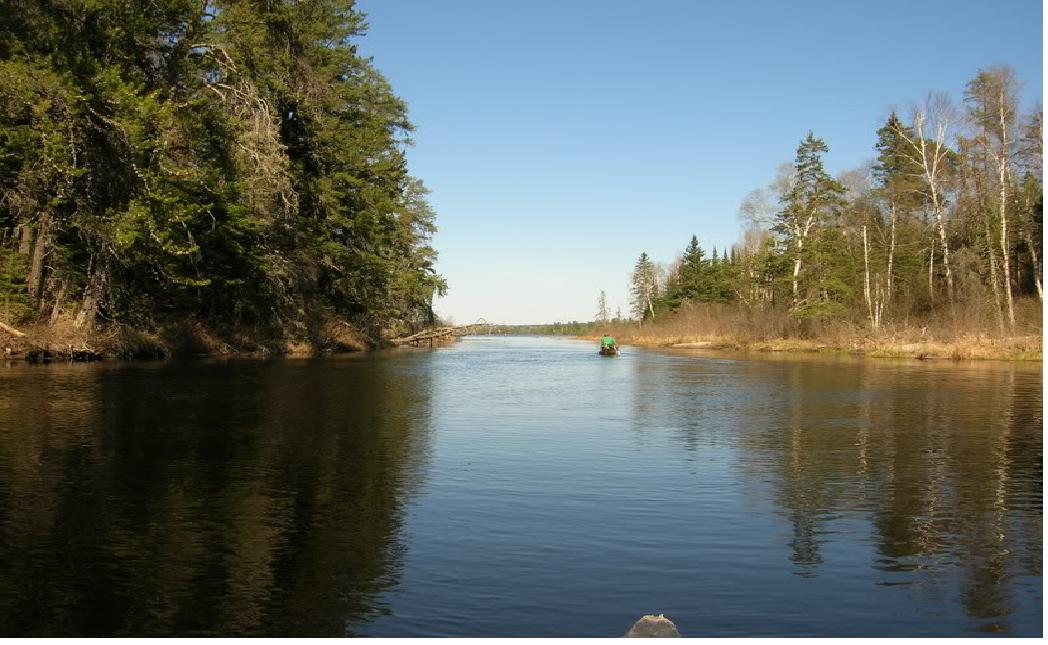
|
01/19/2018 08:54AM |
Hans, what layup is your white Voyager with black rails? Purdy..
|
01/19/2018 11:41AM |
Rivermagic: "I emailed Wenonah yesterday to ask about cost of building a Voyager with less free board, I'll post the response. I enquired about one in tuff-weave for durability, but gosh 50+ pounds?
Hans, what layup is your white Voyager with black rails? Purdy.."
You may want to compare the price if available so modified to an Advantage. it has a lower depth across dimensions. While off the ad listings they pulled a mold out of storage to lay up mine.
I do like it better than the Voyager.
butthead
|
01/19/2018 12:12PM |
Rivermagic: "Hans, what layup is your white Voyager with black rails? Purdy.."
My Wenonah Voyager is the Kevlar-Flex Core lay-up. The pictures below show a better view of the interior of my Voyager with the Kevlar Flex-Core construction.
I generally prefer the more durable, heavy-duty lay-ups with a gel-coat for a tripping canoe. Although a gel-coat can to added to the Kevlar Ultra-Light lay-ups for better abrasion resistance, the gel-coat adds approximately four to eight pounds to the canoe's overall weight depending on the pigment of the gel-coat and the particular canoe model. Even with the gel-coat, I usually put a strip of "Gorilla Tape" on the stems when tripping in rocky wilderness areas such as the "Canadian Shield".
The only canoes in my livery that are the light-weight Kevlar lay-ups are my wife's Bell Magic, that's constructed with the "Kev-light" lay-up, and a Kevlar Ultra-light Wenonah Encounter that I bought for my son.
My wife's Bell Magic and my son's Encounter were pre-owned, so I had no choice in their construction when I bought them. When I purchased my Northstar Magic in "BlackLite", I special ordered it with an Almond gel-coat. Of course it added some weight to the "BlackLite" lay-up, but it also adds abrasion resistance and protects the lay-up's fibers which I prefer.
Even at 46-pounds, I still find the weight of my Kevlar Flex-Core Voyager to be a manageable weight to portage, even with a moderate pack.
Hans Solo
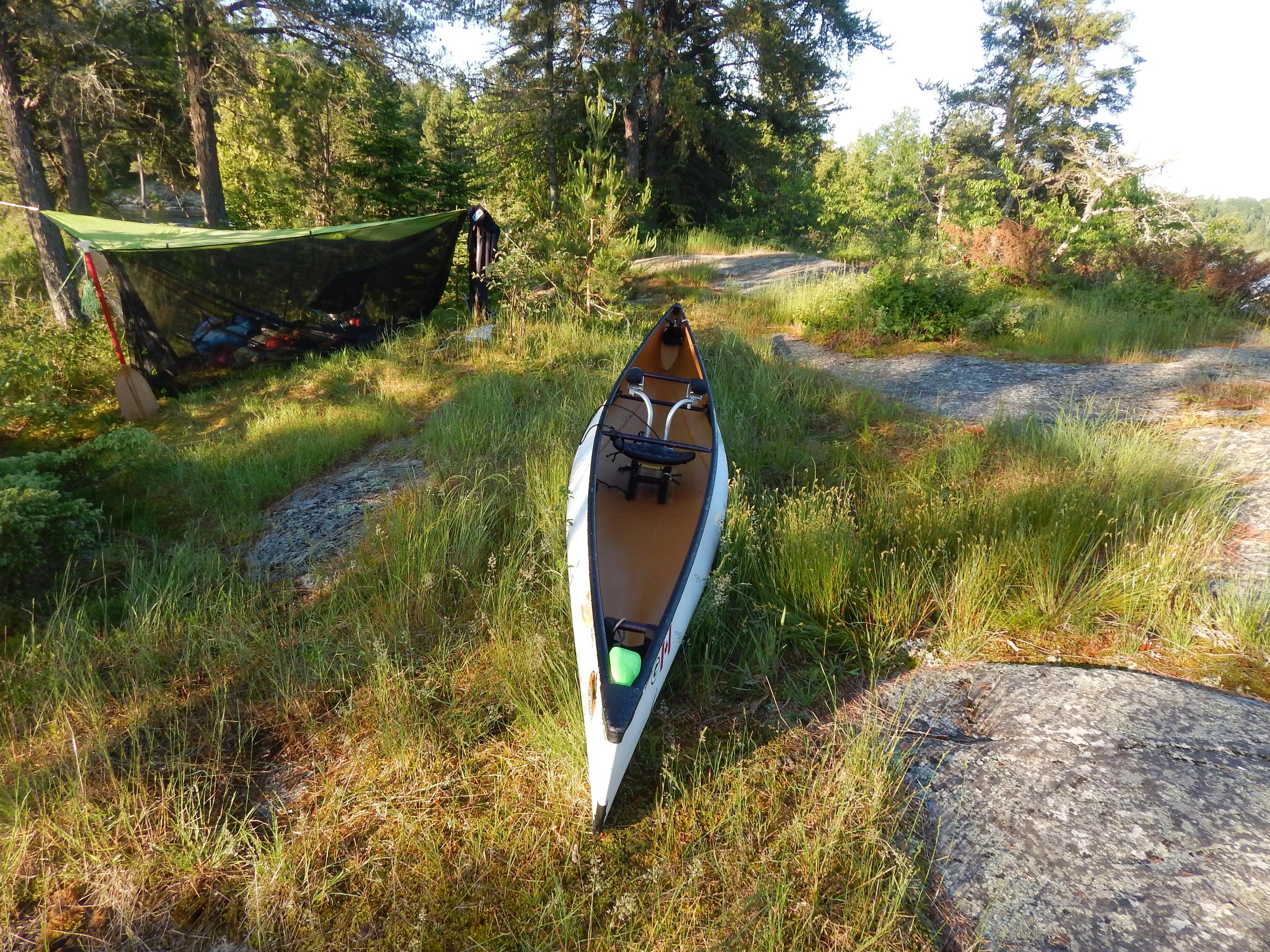

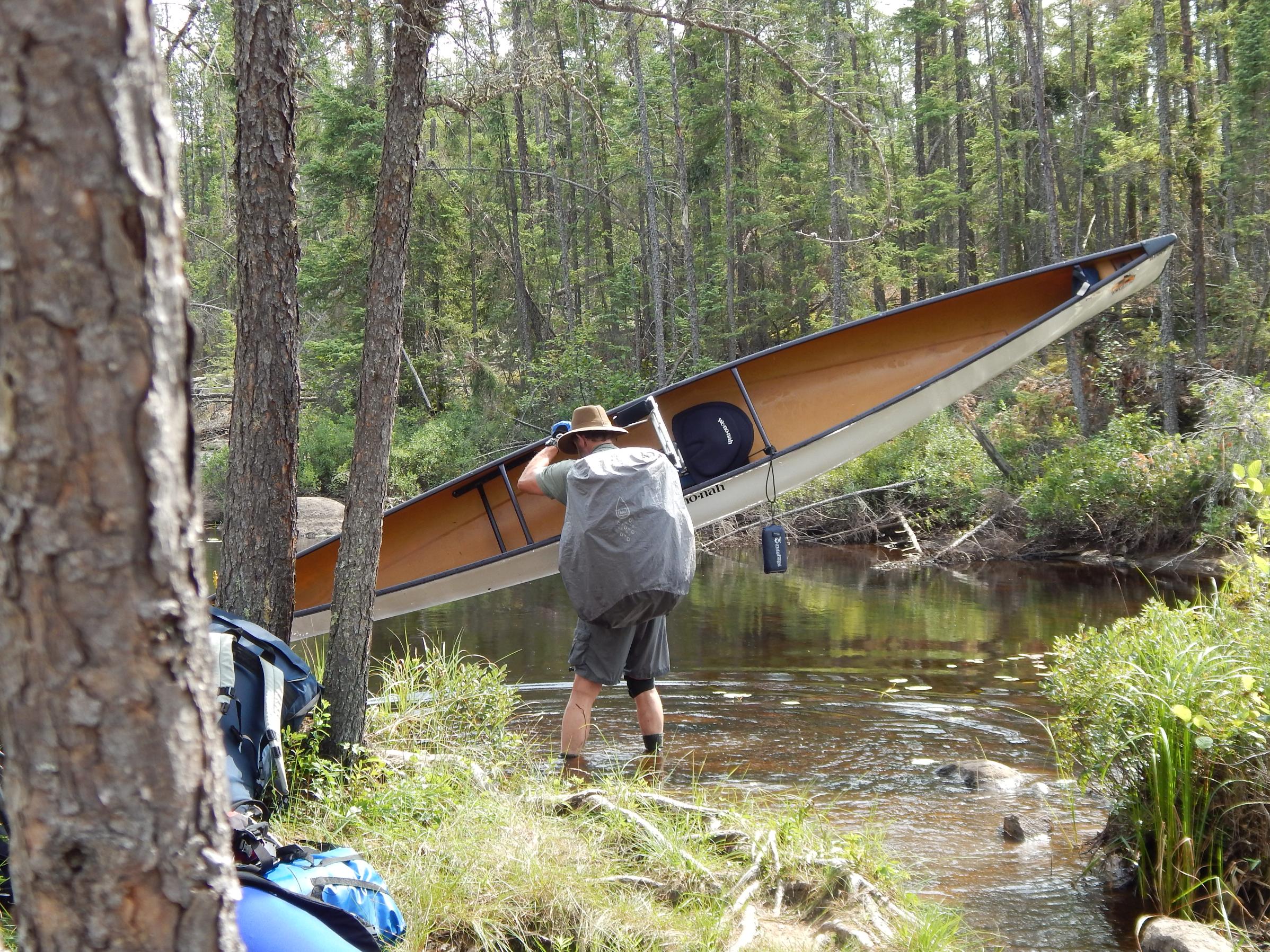
|
01/19/2018 01:18PM |
Continued thanks!
|
04/12/2018 01:01PM |
When I first started I had no problem maxing out my heart rate (180-185) in a kayak with double blade. But in a canoe with single blade I struggled to get much over 145 even when sprinting. As my technique improved my heart rate went up and so did my speeds. Guess it took a while to figure out how to get the most out of those muscles with that technique.
Of course those numbers won't apply directly to you but it doesn't take long to get a ballpark.
Alan
|
01/22/2018 12:59PM |
Dana, Thank you for contacting us with your question on building a modified Voyager. There are many modifications we can make when custom building a canoe, but changing the depth is not one of them. Perhaps the Advantage, which offers less free board would be of interest. Happy paddling
|
01/22/2018 02:15PM |
jcavenagh: "When I buy a red canoe, I'll fly by the rest of you slackers!! ;-0"
I think Ferrari makes a red canoe
|
04/06/2018 08:59AM |

|
01/23/2018 10:02AM |
Rivermagic: "I've actually been thinking of I were to get either a Voyager, Advantage or new Magic I would get red ??"
From what you've written so far I'm going to guess that at this point in your canoe racing career whatever you get now will probably be replaced by something else in the not too distant future. I'd highly recommend buying used. Everything you're looking at is available on the used market for way less than it would cost to buy new. If/when you tire of the boat you can sell it for probably the same amount you invested into it.
Don't get too worked up about layup and weight. Yes, lighter is faster but not by much. It makes a much bigger difference off the water than on. Remember that it's total weight that matters. A 200 pound paddler in a 25 pound boat shouldn't be any different than a 175 pound paddler in a 50 pound boat.
Alan
|
01/20/2018 04:35AM |
schweady: "quote butthead: "...That's when I look at my speed to make sure I'm not moving backwards.
butthead"
Oh, yes... Easy to relate.
"
Yep. It's an odd phenomenon.
|
01/20/2018 06:29AM |
jhb8426: "I go faster when I paddle into the wind. I can feel it in the wind on my face..."
That's the way it feels to me, too :)
|
01/17/2018 08:25AM |
Rivermagic: "And I appreciate Alan your insight into getting 2-3 more hits per side, but not gaining that much speed in the Voyager. "
But don't forget that if you're in it for racing and fitness a couple tenths of a MPH is huge when you're paddling hard all day long.
I raced my Magic once and someone else was in a Voyager. The wind was crazy that day and he was the only one at the starting line having a problem with his boat getting blown around. He ended up capsizing before the race was over but don't know if you can blame the boat as I nearly did a couple times too.
I think what you really need for those races is a rudder.
Alan
|
01/17/2018 08:53AM |
|
01/17/2018 09:04AM |
MagicPaddler: "I rented a canoe with a rudder for a 5 day trip. With the rudder down and the wind blowing on the side of (including quartering into the wind) the back of the canoe does not slip sideways but the front does. The rudder will not turn far enough to allow the canoe to be steered. Rudders are for down wind only."
A very good description of how an Advantage handles side wind. It has a very deep and squared of stern stem.
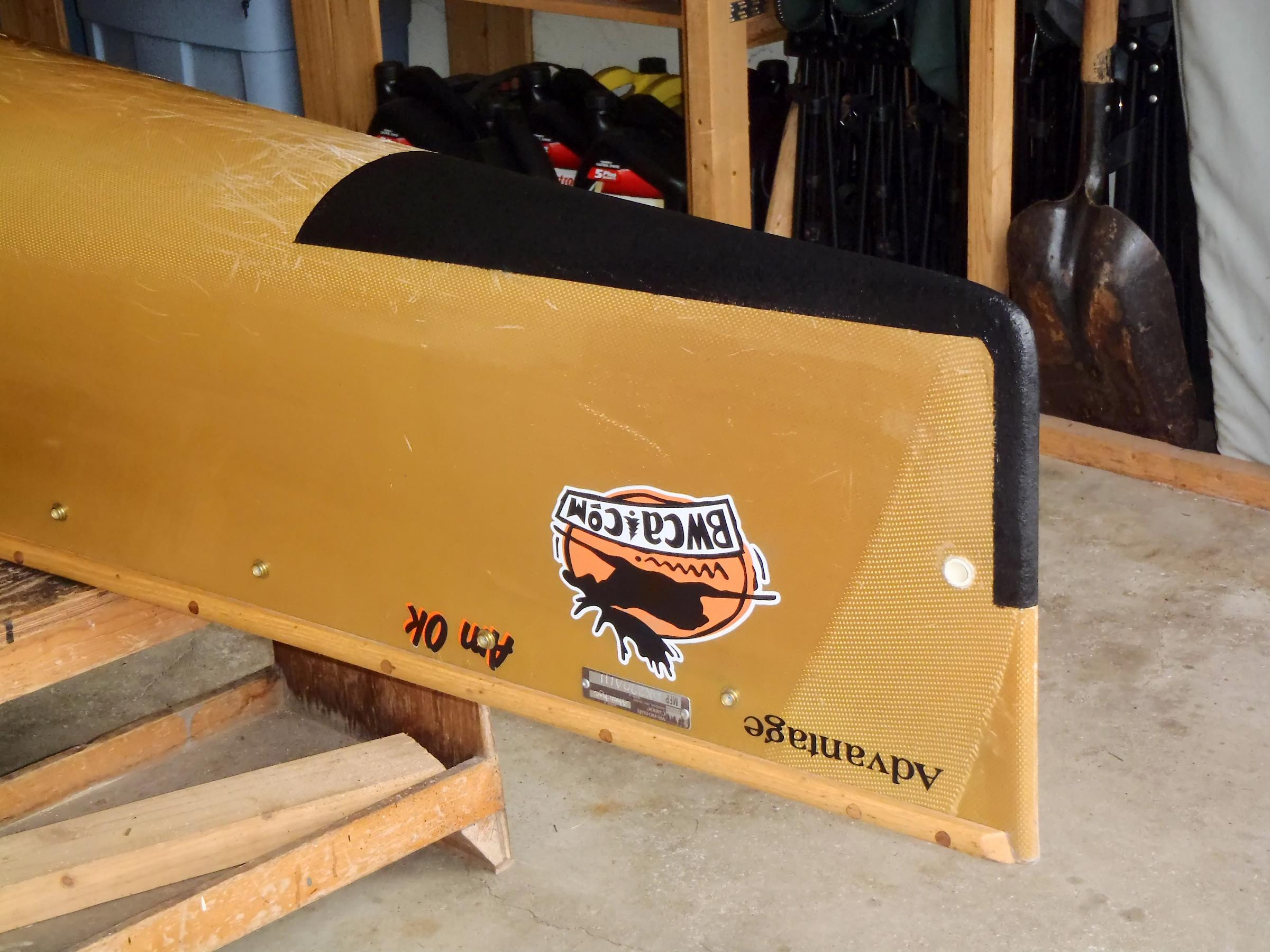
Far as the speed comments I can get it up to 7mph in a very short sprint. I did not buy it for that and hardly ever exceed 5, cruise mostly around 3. I bought it cause I'm lazy and like the glide/paddling ratio for long tripping.
butthead
|
01/19/2018 01:50PM |
|
02/19/2018 11:31AM |
|
02/19/2018 11:15AM |
Alan
|
02/20/2018 04:52PM |
|
02/20/2018 05:36PM |
Some on here use Gorilla tape, others use spray on bed liner.
Another option is to just use it until you need to repair it--then patch it with something more durable.
|
02/20/2018 05:28PM |
Rivermagic: "I also wanted to ask what I should do to protect this seemingly very fragile hull. I really don't think I want to put skid plates on but will if I have to and learn how. Other things I can do? "
I personally would not put Kevlar felt skid plates on a composite canoe. Kevlar skid plates ruin the fine lines of the hull. Kevlar felt skid plates were really intended to protect the thin vinyl skin on Royalex hulls, not composite canoes. Still many owners of skin coated Ultra-Light Kevlar canoes use the felt Kevlar kits anyway; to each their own.
The Ultra-light Kevlar hull itself is repetitively tough for it's intended purpose; flat water paddling. Wenonah, like most other manufacturers of Kevlar canoes, beef-up the stems of their canoes by laying multiple layers of Kevlar fabric in the stems when constructing their hulls. The bigger problem is the thin skin coat that can be abraded quickly and easily by rocky shorelines. Without a thick gel-coat, abrasive shorelines, or river and lake bottoms for that matter, will expose the fabric quickly.
A cheap, easy and temporary solution would be to just put duct tape skid plates on the stems when you're traveling in scrappy conditions. You could also apply a product called KeelEazy.
KeelEazy
If you are paddling in scrappy conditions the majority of the time, then you might consider applying thin layers of S-glass cloth to the stems. S-Glass cloth skid plates are easier to apply and repair. Fiberglass cloth also does not fuzz like the Kevlar fabric does.
Some owners of Wenonah Ultra-light Kevlar canoes order them with internal Kevlar skid plates and/or a clear or pigmented gel-coat. The problem with adding a gel-coat to an Ultra-light Kevlar canoe is that it will add approximately four to seven pounds of weight to the hull, therefore making it not that much lighter than a Kevlar Flex-Core lay-up.
I'm assuming you've purchased the "standard" Ultra-light Kevlar Advantage, so internal Kevlar skid plates, a gel-coat, or the "Outfitter" lay-up are not an option at this point.
Even though most all of my Kevlar canoes have gel-coats, I'll still apply a layer of "Gorilla Tape" to retard some of the gel-coat abrasion when traveling in "Canoe Country".
Just my two-cents worth.
Hans Solo
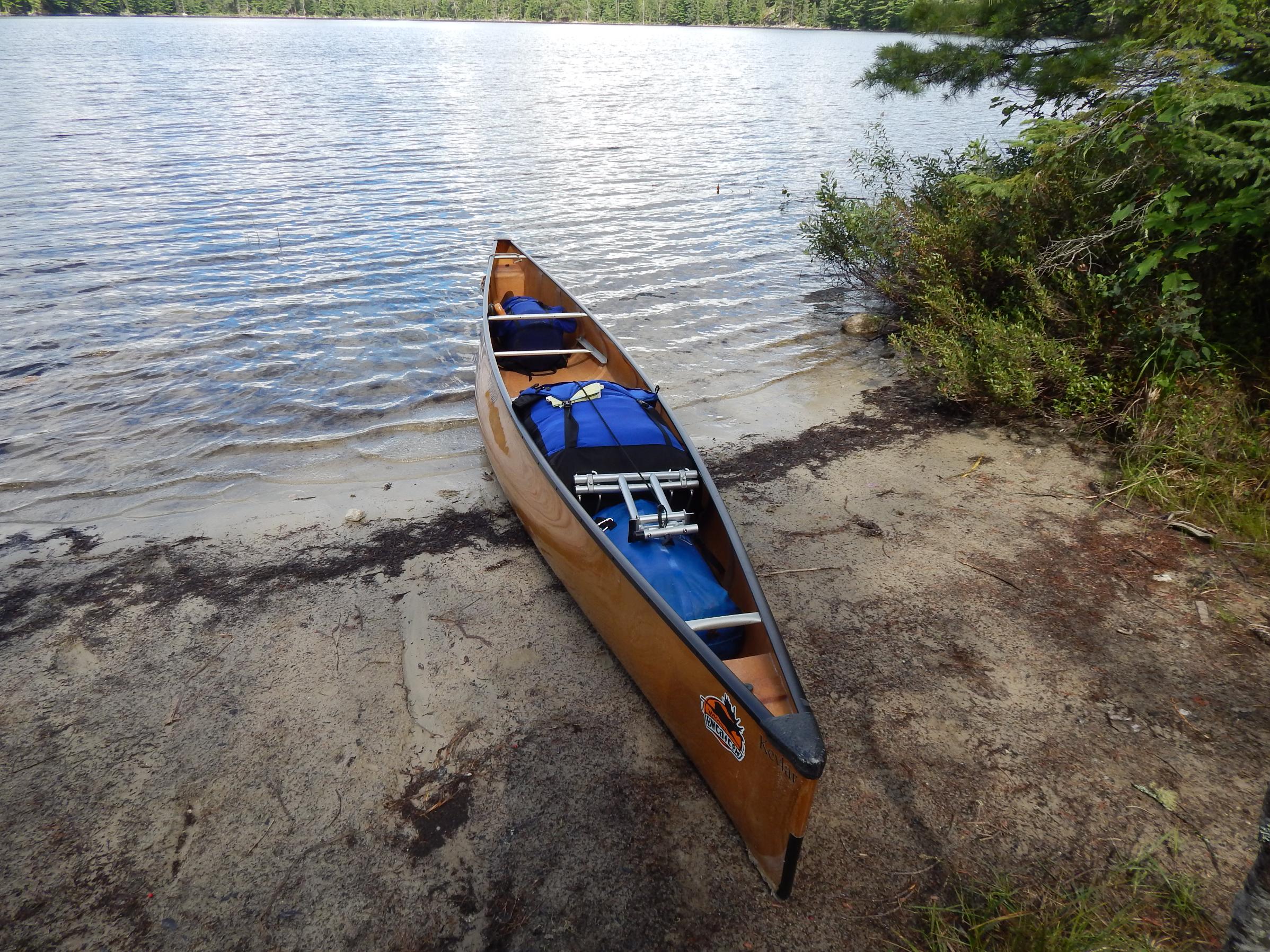
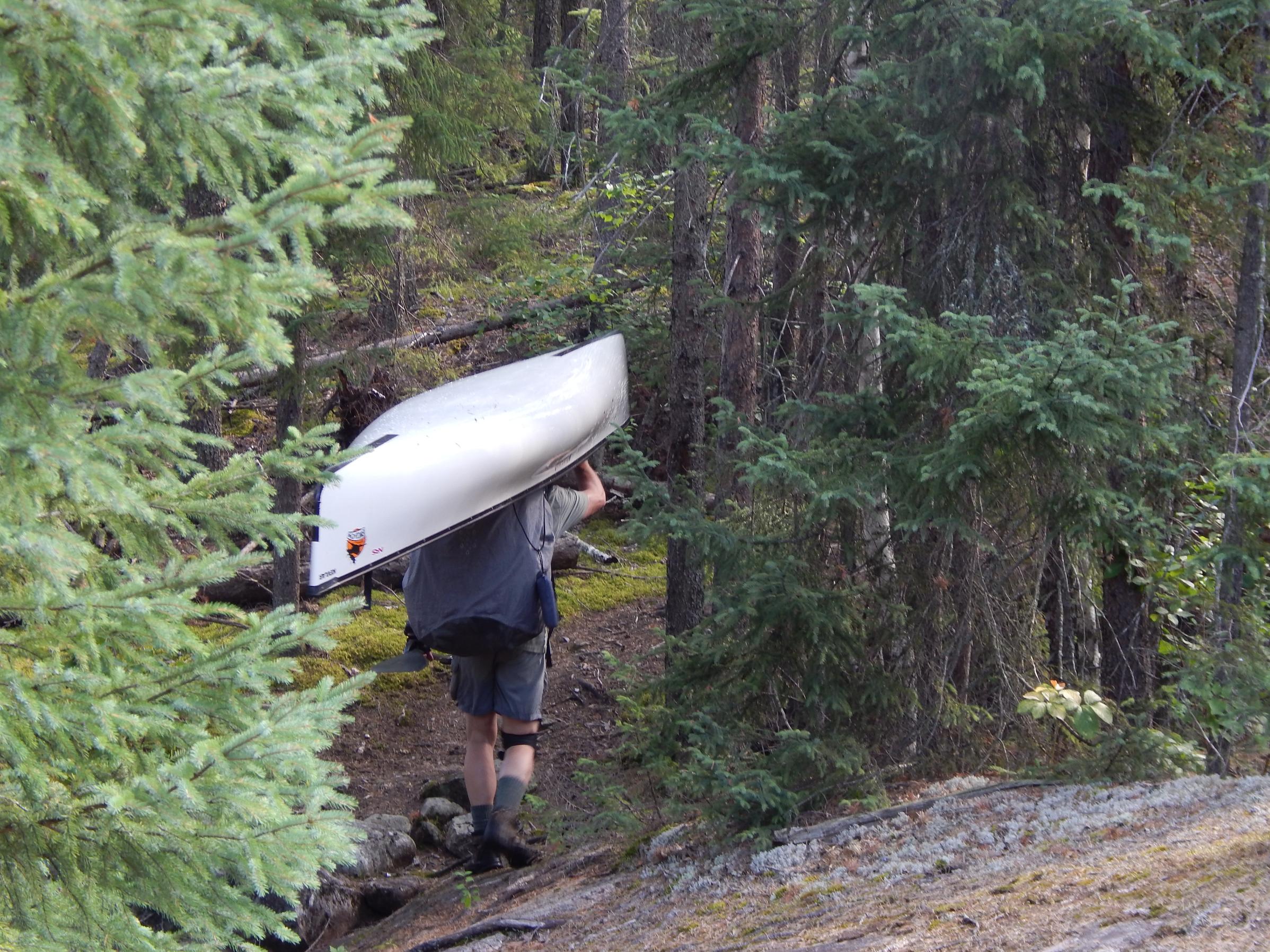
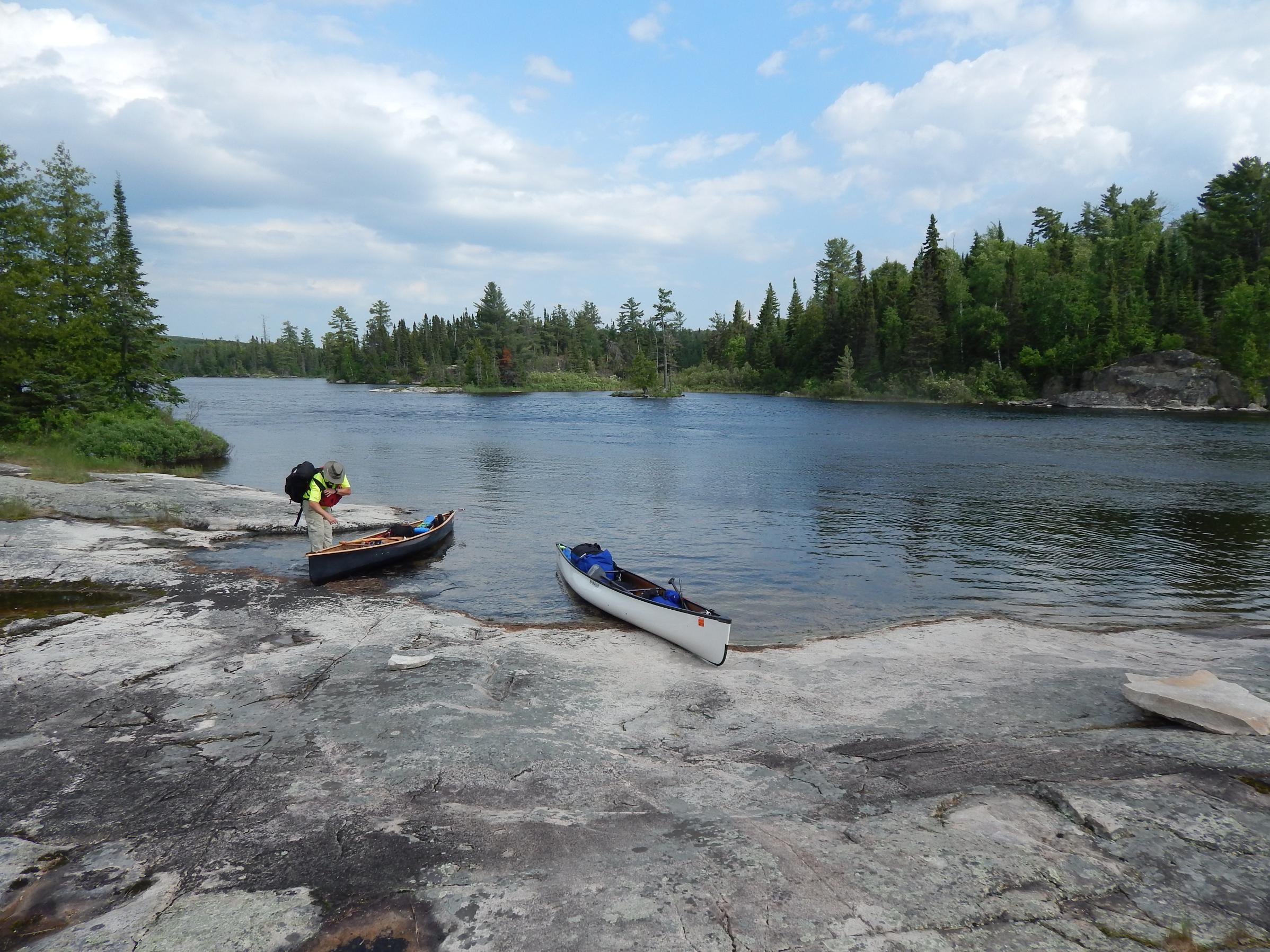
|
02/21/2018 07:57AM |
|
02/20/2018 09:19PM |
You'll find the Advantage becomes much more stable at speed. The faster you go the, the better the stability. They key to staying out of the drink is to never let your head go outside the gunwales. Best to not lean the boat too much- get past the bubble of the tumblehome and you won't even have the chance to think "I'm going over" you'll just be in the water.
I've definitely had the Advantage out in water that I should not have been paddling in, but I've only flipped once on a trip in the thirty years I've paddled her (and that involved a 70# dog and a just boated 15# northern).
|
02/21/2018 05:45AM |
|
02/21/2018 08:46AM |
Rivermagic: "Thanks much for the advice. Sounds like keeleasy and gorilla tape is a good option. If I were to go with the permanent Dynel what epoxy would you suggest? Also once I can get on the water I'll clock the speed so I'm on topic ?? "
Here's a good discussion Skid plates
And Keel Eazy Keel Eazy
|
02/21/2018 09:08AM |
HansSolo: "
A cheap, easy and temporary solution would be to just put duct tape skid plates on the stems when you're traveling in scrappy conditions. You could also apply a product called KeelEazy.
KeelEazy
Even though most all of my Kevlar canoes have gel-coats, I'll still apply a layer of "Gorilla Tape" to retard some of the gel-coat abrasion when traveling in "Canoe Country".
Just my two-cents worth.
Hans Solo


"
Hans, is that keel easy or gorilla tape in the photos? I am thinking of keel easy on a hornbeck and a placidworks spitfire. Is 2 inch wide enough? We will be wetfooting and careful also.
we have the slower green and black canoes.
|
02/21/2018 09:59AM |
Wick: "HansSolo: "
A cheap, easy and temporary solution would be to just put duct tape skid plates on the stems when you're traveling in scrappy conditions. You could also apply a product called KeelEazy.
KeelEazy
Even though most all of my Kevlar canoes have gel-coats, I'll still apply a layer of "Gorilla Tape" to retard some of the gel-coat abrasion when traveling in "Canoe Country".
Just my two-cents worth.
Hans Solo


"
Hans, is that keel easy or gorilla tape in the photos? I am thinking of keel easy on a hornbeck and a placidworks spitfire. Is 2 inch wide enough? We will be wetfooting and careful also.
Don't use gorilla tape. I though it was a great idea but it is tough to get off although I have been too lazy to try options other than picking away at it. Keel Eaz or however it is spelled isn't too bad to put on. Rutabaga sells it by the foot in various colors.
we have the slower green and black canoes."
|
02/21/2018 03:51PM |
|
02/21/2018 11:46AM |
The black strips shown in my photos below are just two layers of Gorilla Tape.
Due to the fact most all of my Kevlar canoes have gel-coats, the Gorilla tape is adequate in providing a little additional abrasion resistance to the gel-coat. My son's Wenonah Encounter is a Kevlar Ultra-light lay-up with a skin coat and I would like to eventually apply the KeelEazy skid plates to his solo canoe. The Gorilla Tape has been adequate at protecting the stems of his Encounter. Unfortunately the previous owner of the Encounter had applied narrow strips of Kevlar felt on the stems of the Encounter, which is something I would never have done.
Soon after I bought the Encounter, I had a professional boat repair shop sand down the Kevlar felt skid plates in-order to return the hull as close to stock as possible. The shop did a good job of smoothing out the stems and physically getting the hull close to its original shape. The technicians at the shop also applied a thin layer of resin over what remained of the Kevlar felt material. As a result of the original owner's treatment, the Encounter does have some additional Kevlar material on the stems, despite the best efforts of the boat shop to remove the skid plates. So as a result of the additional material and resin, the Gorilla Tape is probably adequate.
Despite using additional abrasion resistant materials to the stems of my canoes, I still wet foot it in "Canoe Country". I personally don't know any owners of composite canoes that run their canoes up on the shoreline like they might with an aluminum canoe, unless it's a sandy beach or some other soft shoreline. Anyone who has paddled and tripped on the Canadian Shield realizes landings can be very abusive to a composite canoe despite the paddler's best effort.
When I'm not canoe tripping in areas like the BWCAW, Quetico, Woodland-Caribou, etc., I spend a lot of time paddling and canoe-camping on the lower Wisconsin River near my home. Due to the fact the beaches and river bottom of the lower Wisconsin River are primarily sand, additional stem protection isn't really necessary. That's why I prefer an inexpensive and temporary solution like Gorilla tape that can be easily applied or removed depending on conditions. The same can be said for many of the other streams and lakes I paddle on a regular basis near my home. The shores are either sand or mud, so landings are not that abusive.
Hans Solo



|
02/21/2018 06:01PM |
|
09/13/2016 02:25PM |
I paddled both with a kayak paddle and the lake was glass.
Bell Magic
cruising speed 4.75mph
hard paddle 5.8mph
max 6.1mph
Osagian 15' aluminum battle wagon(standard flat bottom aluminum, minimal rocker, 35"beam)
cruising speed 3.75mph
hard paddle 4.5mph
max 5.0mph
|
09/13/2016 03:25PM |
|
09/13/2016 07:09PM |
|
09/13/2016 07:18PM |
|
09/13/2016 08:20PM |
|
09/13/2016 09:41PM |
quote bhouse46: "I have paddled along side Jim, he cuts a pretty good wake. Now to calculate going into and down wind and all the other variables. Final comment, go Magic. "Thank you, Thank You.
There was a magic listed in the for sale / wanted link on Ebay in Wisconsin just recently. Did anybody on here buy it? What would a good price for one be? I see the outfitters selling their scratched up ones for $1800-$2000, and they sell fast. The one on Ebay was $1500 and it lasted a week, Why?
|
09/14/2016 08:27AM |
|
09/14/2016 10:51AM |
More skin with less horsepowered paddlers=slower. The goal is to match the boat with the paddler. Gals can keep up to their solo mates in a Magic if they use something with less skin like a Kestrel.
Test is incomplete. I'd like to see comparison with a sit and switch style
So you may not keep up with Jim even if you have a Magic.
Paddling is a partnership
1.55x square root of waterline length is hull speed. Its very hard to go over that due to wavemaking resistance.
Jim was right there. Its heroic to go over 6.1
|
09/14/2016 11:38AM |
quote billconner: "Man, I go tripping to relax and get away from the rat race and last thing on my mind is canoe speed and going fast."
I just look down at my GPS for direction to a spot. The same screen shows you your speed. I just did a speed run for a few seconds. Trust me when I say I do a lot of relaxing. :)
|
09/14/2016 12:18PM |
quote billconner: "Man, I go tripping to relax and get away from the rat race and last thing on my mind is canoe speed and going fast."
I don't care about speed either, but I do care about efficiency and the speed usually equates to how efficient the hull is. Bottom line is that I like to cover a lot of miles (not a base camper unless on a portage clearing trip), and how efficient my boat is determines how many miles I can cover during a trip. The water is always wetter on the other side of the portage, right?
|
09/14/2016 01:33PM |
quote butthead: "...That's when I look at my speed to make sure I'm not moving backwards.
butthead"
Oh, yes... Easy to relate.
|
09/16/2016 11:10PM |
quote missmolly: "quote Savage Voyageur: "quote yellowcanoe: "quote PortageKeeper: "quote billconner: "Man, I go tripping to relax and get away from the rat race and last thing on my mind is canoe speed and going fast."
but I do care about efficiency and the speed usually equates to how efficient the hull is."
Nope. The efficiency is how well you plant and recover your paddle and how well your cadence is matched to the paddle design and how well you are matched to the boat.
Size matters.. Little short armed person with less strength needs less boat to keep up with bigger stronger paddler in bigger boat.
That is the underlying principle why Dave Curtis builds multiple size boats at Hemlock Boat Works. He understands physics and I don't see any interest of that here."
Please explain how hull efficiency does not equate to speed because my brain is hurting right now.
"
It's easy breezy:
v = v0 + at
x = x0 + v0t + ½at2
v2 = v02 + 2a(x ? x0)
v? = ½(v + v0)
and
a? = ?v
?t
a = dv
dt
and
v? = ?s
?t
v = ds
dt
Glad I could help!
"

|
09/17/2016 03:02PM |
quote billconner: "Man, I go tripping to relax and get away from the rat race and last thing on my mind is canoe speed and going fast."
Most everyone on this site basically paddles for pleasure, regardless of what canoe they are paddling. Whatever canoe or kayak gives you those most enjoyment for whatever reason, that's awesome and ultimately that's what it is all about.
That being said, I love fast canoes, especially fast solo canoes! It's not to set speed records, or to beat one of my trip partners across the lake or down the river, I just find fast "sit and switch" style canoes to be the most enjoyable, at least for me.
I have never "clocked" any of my canoes with a GPS, but I can tell you I'm generally out in front of the pack when I'm paddling my Wenonah Voyager, Sawyer DY Special, Shockwave, etc. I consider myself a strong and capable paddler, but I'm not Verlen Kruger either.
Much like fast cars, I personally find fast canoes more fun. Although all motor vehicles are bound by posted speed limits and other DOT regulations, driving a Porsche is a lot more fun than driving a Buick LaSabre IMHO. :-)
Hans Solo
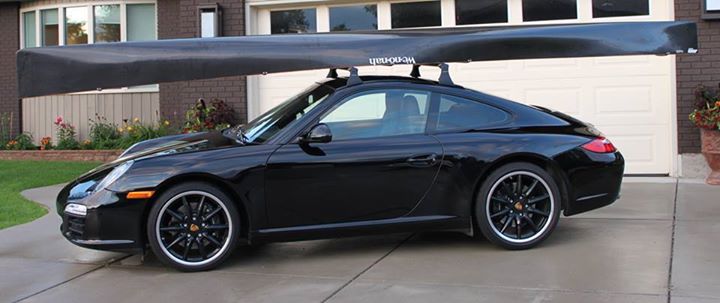
|
09/17/2016 07:29PM |
|
01/12/2018 11:13PM |
|
01/13/2018 02:14PM |
|
01/13/2018 02:58PM |
|
01/14/2018 10:35AM |
I find now, when I want to compare to hulls, I call up Alan Gage, and go for a paddle !
After about a half hour, we switch canoes. When I lag Way behind Alan, or I notice, he's Coasting a lot, I'm in the slower hull.
Having someone, side by side to race with, won't give you numbers, but it will sort the Fast, from the Slow !
Jim
|
01/13/2018 11:01AM |
Rivermagic: "I'm curious if someone can speak to something related to speed, sit and switch paddling. How would a Magic compare to a Blackwater or Voyager in terms of strokes per side before needing to switch sides? Perhaps it is my technique but when paddling really hard with my Magic I get maybe 4-5 strokes per side. Would one of these other boats be different or is it me. Thanks"
I can’t comment on how the Savage River Blackwater performs and tracks using sit and switch paddling techniques, because I haven’t had the pleasure of paddling a Blackwater. (Savage River canoes are pretty rare here in Wisconsin.) I own a Magic, a Voyager and several other sit and switch style solo canoes that I can comment on though.
As you probably know, in-order to maximize the most strokes per side before switching, it’s important that the paddle is as near vertical as possible, you’re following the keel-line of the hull, (not the gunnels) , and you’re not continuing your stroke beyond your body. I’m assuming your canoe is properly trimmed as well. That being said, five to six strokes per side is not unreasonable in a Magic, although four to five strokes is probably more the norm, depending on technique and conditions. Although the Wenonah Voyager tracks somewhat better than the Magic, I’d say six to seven strokes per sides is about average before switching. The Wenonah Encounter also tracks well, especially when loaded, and is also a good performer, but not quite the rocket the Voyager is.
Probably the best tracking solo canoe I’ve paddled and own is the Sawyer DY Special. The DY Special @ 16’ 8” compares closely in design to the Sawyer Shockwave, also 16’ 8”, the Wenonah Advantage @ 16’ 6”, and the Savage River Blackwater @ 17’. Much like the Voyager, the DY Special, Shockwave, Advantage and the Blackwater have little or no rocker, unlike the Magic which has differential rock, (1.5” bow/.75” stern).
The DY Special has more of a shallow V hull design when compared to the Blackwater, Shockwave, Advantage and the Voyager, thereby making it a bit better tracking than the others. Still, seven strokes per side in a DY Special is about maximum average before the canoe “turns off” course too much.
Again, I can’t speak to the performance of a Savage River Blackwater, but of the sit & switch style solo canoes I own and paddle, (i.e., Sawyer DY Special, Shockwave, Summersong @ 15' 4", Wenonah Jensen C1W @ 16' 6", Wenonah Encounter @ 17', Mad River Traveler @ 16' 3", Wenonah Voyager @ 17' 6" and the Bell/Northstar Magic 16'), the Voyager is the fastest of the bunch, but not drastically. The Sawyer DY Special tracks the best of all the aforementioned solo canoes though.
I hope my reply answers your question.
Hans Solo
(from left to right; Wenonah Encounter, Voyager, Sawyer Shockwave & Summersong, Sawyer DY Special, Mad River Traveler, and Wenonah Jensen C1W @ 16' 6")

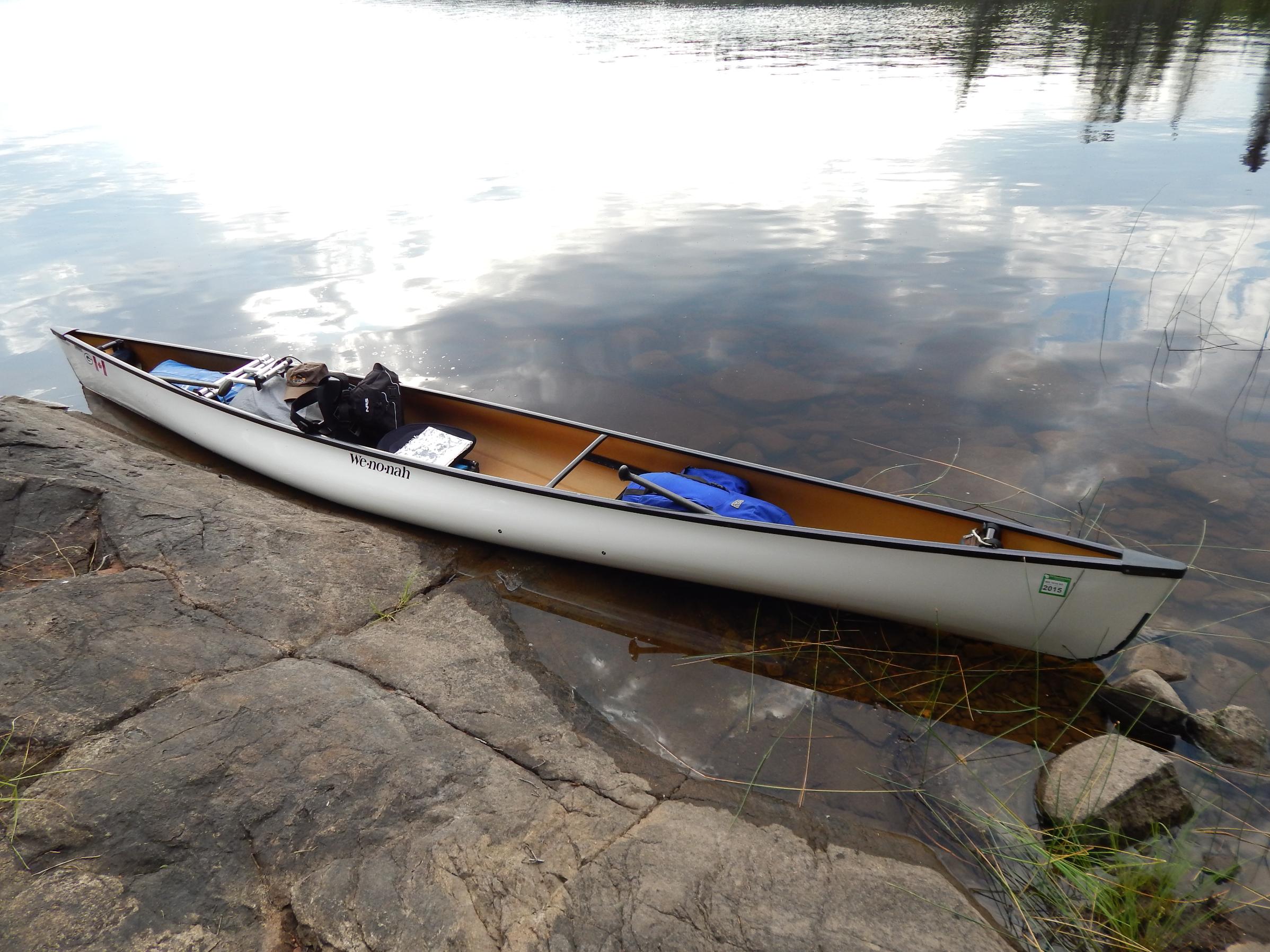

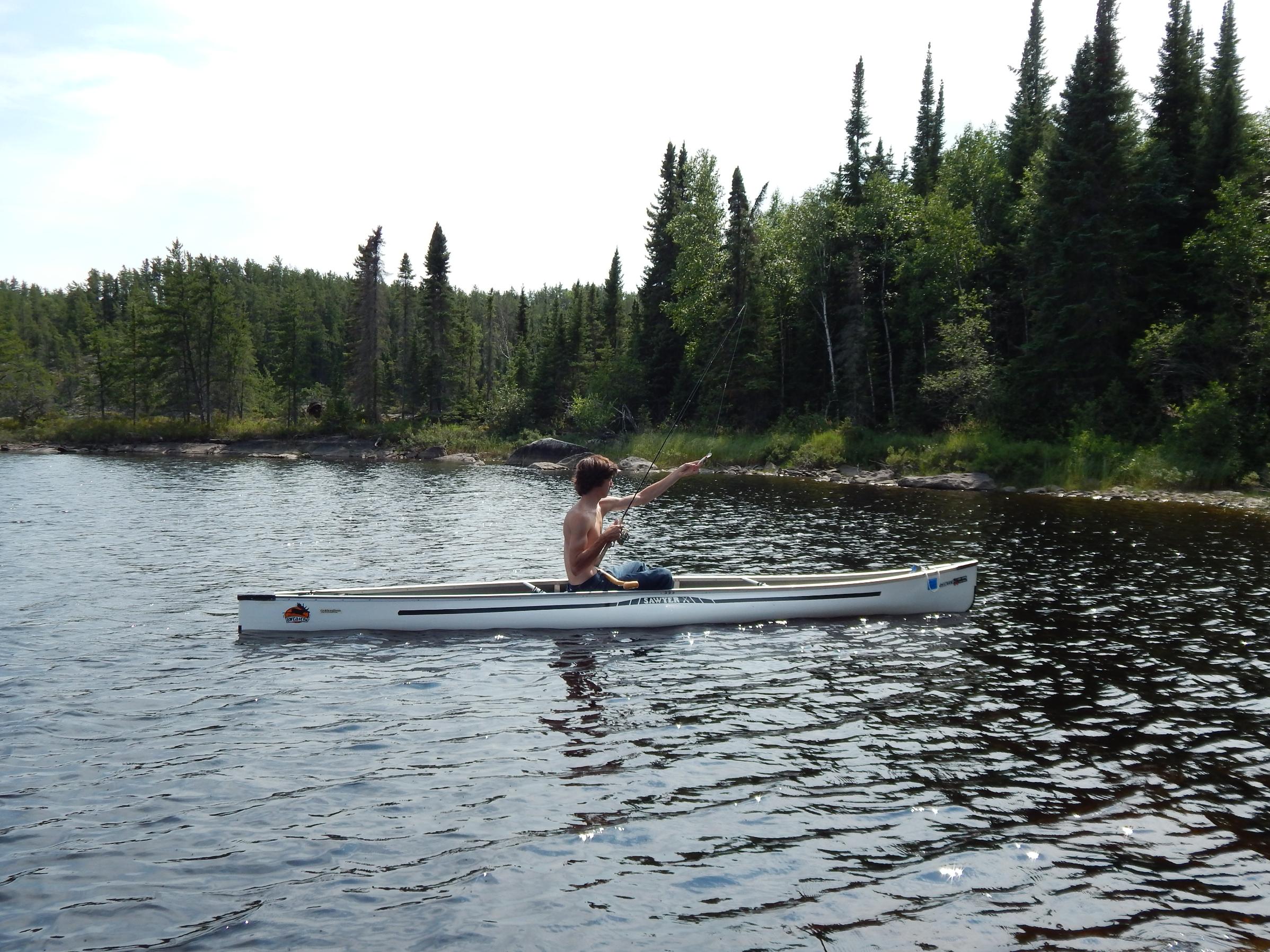

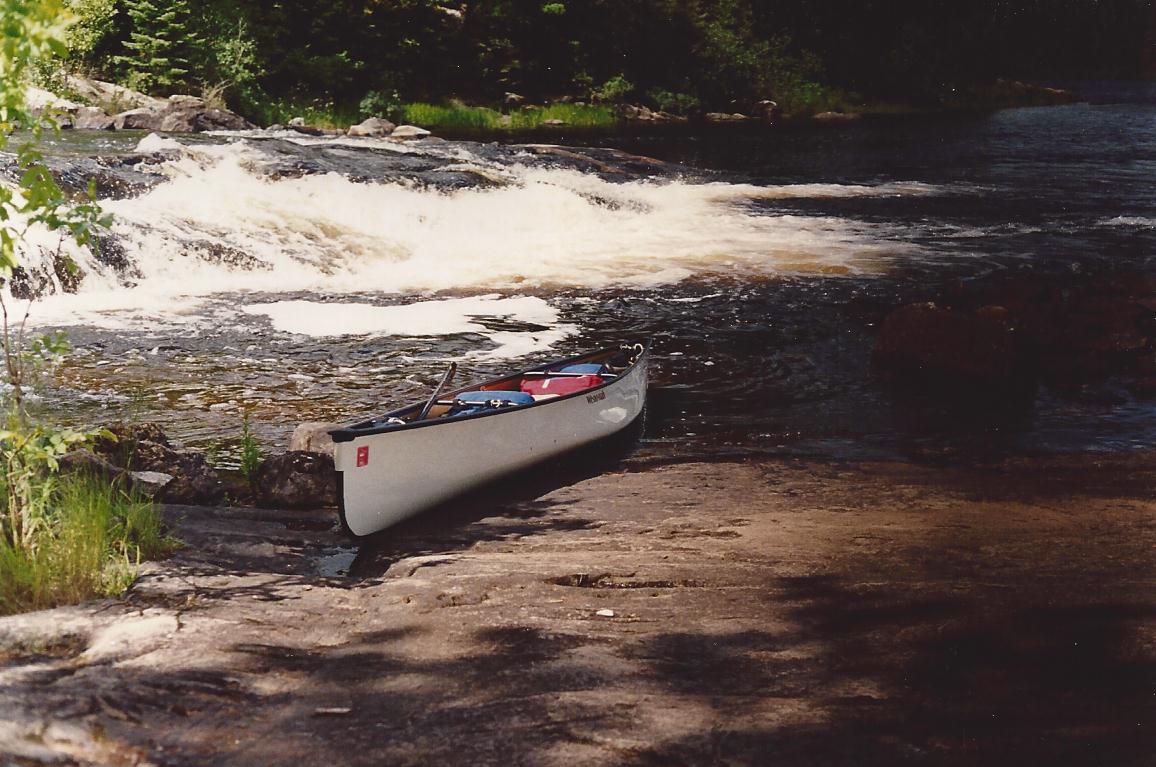
|
01/13/2018 07:22PM |
nooneuno: "I only paddle fast if I hear banjo's...."
Okay, that's funny!
Dave
|
01/13/2018 07:28PM |
HansSolo: "Rivermagic: "I'm curious if someone can speak to something related to speed, sit and switch paddling. How would a Magic compare to a Blackwater or Voyager in terms of strokes per side before needing to switch sides? Perhaps it is my technique but when paddling really hard with my Magic I get maybe 4-5 strokes per side. Would one of these other boats be different or is it me. Thanks"
SSOLO-020313-003658.JPG" align="left" > "
Very good info.
|
01/13/2018 09:44PM |
|
01/14/2018 01:00PM |
Rivermagic: "Thanks Hans, super helpful info. That's an impressive stable I must say. I traded my white gold Magic but now my friend has a black gold Magic which I am really lusting, but have really been thinking about a Voyager. I just can not afford a Blackwater realistically. The things I don't like about the Voyager are the high sides and the tougher layups are so heavy. Black gold or black lite Magic really seem about perfect, light and tough, if I could only get 2-3 more hits per side and another 1 mph. 2-3 more hits and faster speed of the Voyager is very tempting indeed, however wind in the river could easily neutralize that advantage. DY special, and Shockwaves are tough to find aren't they?"
You’re welcome River Magic! I always enjoy talking sit and switch solo canoes. I made mention of the solo canoes in my “stable” that are of a similar vein and are somewhat comparable in design and performance.
Yes, Sawyer DY Specials and Shockwaves are hard to come by these days. On paper, the DY and Shockwave have almost identical specifications. The DY Special tracks slightly better than the Shockwave though, but the Shockwave performs better than the DY Special in shallow water due to some particular differences in hull design. The Sawyer Shockwave compares more closely to Wenonah’s Advantage with regards to shallow water performance. Regardless, both the DY Special and the Shockwave are Dave Yost designs and are both fun to paddle and user friendly IMHO.
Although I haven’t found the high sides of the Voyager to be an issue, it’s a better tripping solo than the Sawyer DY Special or the Sawyer Shockwave due to those higher sides, (and the subsequent deeper hull), which makes for a drier ride than the aforementioned Sawyers solo canoes.
You’re right about the Wenonah Voyager’s tougher lay-ups being heavier in comparison. The same can be said for the Wenonah Encounter, Wenonah Jensen C1W, and the Mad River Traveler.
You’re also correct in saying that wind and current does change things up. The examples of strokes per side when paddling sit and switch that I mentioned are under ideal conditions.
Hans Solo


|
01/14/2018 01:29PM |
1JimD: " I used to try and compare one hull to another, using a GPS, but there always seemed to be a lot a variables to deal with !
I find now, when I want to compare to hulls, I call up Alan Gage, and go for a paddle !
After about a half hour, we switch canoes. When I lag Way behind Alan, or I notice, he's Coasting a lot, I'm in the slower hull.
Having someone, side by side to race with, won't give you numbers, but it will sort the Fast, from the Slow !
Jim"
Good point Jim!
Often when the topic of hull design and speed are discussed, it can frequently become overly technical. Although there's no denying the laws of physics, but more often the "eye test" is more relevant under real world applications.
As you've noted, test paddling different models and comparing the performance of various canoes usually determines what canoe(s) perform the best for a persons needs, their expectations, or ultimately what canoe(s) are the most enjoyable to paddle.
Hans Solo
|
01/19/2018 01:37PM |
Rivermagic: "How does that compare in stability with a Voyager and a Magic since I'm familiar with Magic. Continued thanks!"
Although I don't own a Wenonah Advantage, I have spent some time paddling an Advantage when I worked at Rutabaga.
In my opinion, (and from my experience), the Advantage has more initial stability than the Wenonah Voyager or the Bell/Northstar Magic. That said, the Advantage has less secondary stability than the Magic or Voyager, due to the more pronounced tumblehome. The Voyager is a better solo tripping canoe than the Advantage in my opinion due to its greater depth/freeboard. In other words, the Voyager is a drier ride and handles big water much better than the Advantage in those conditions. I have never been wind bound in my Voyager.
I like all three canoes, but when the Wenonah Advantage was first produced and cataloged in the 80's, there was no Voyager, Encounter, Prism or Wenonah Wilderness. At that time, the Sawyer DY Special and Advantage were popular solo canoes and there wasn't a lot of true wilderness tripping solos to chose from. The DY Special and the Advantage were more cruising/ light touring class solo canoes, not really designed for extended tripping. Design wise, the Advantage compares more closely with the Sawyer DY Special and the Sawyer Shockwave. Think Chevy Camaro compared to Ford Mustangs. :-)
I personally preferred the Sawyer DY Special to the Advantage at that time. I personally felt the DY Special was more user friendly and less affected by a quartering wind than the Advantage. For what it's worth, the DY Special and Shockwave were Dave Yost designs, like the the Magic. Whereas the Advantage, Voyager, Prism, and Encounter are Dave Kruger designs.
The DY Special was my tripping solo from 1982 until 1988. As good as the Dy Special was, I wanted a solo canoe with more freeboard in-order to be a drier ride in "big water". I also wanted a solo canoe that had more cargo capacity, but I didn't want to give up performance, so I upgraded to a Wenonah Jensen C1W, which was a Gene Jensen design, hence the model name. It was 1988 and there was no Voyager, Encounter, Prism or Wilderness then.
As much as I liked the Jensen C1W, it wasn't as dog friendly as the DY Special. The Jensen C1W was actually designed to be an ACA downriver/whitewater racer first and foremost, and a solo tripping canoe second. It worked well as a big water tripper, it turned easier than the DY Special, and therefore the Jensen C1W was better suited for whitewater or more technical rivers. That said, the Jensen C1W's hull is rather tender and is very trim sensitive, more so than the other solo canoes discussed here. I loved the canoe and still own one, but it can be somewhat sketchy with a big, active Golden Retriever on-board.
Looking fora solo tripper that was more user friendly, I special ordered my current Kevlar Flex-Core Voyager a Canoecopia in 2004 and it has been my primary "Canoe Country" solo tripper ever since. I personally find the Voyager to have decent initial and secondary stability, and more user friendly than the Jensen C1W. The Voyager hull is a bit more lively than the Prism and the Encounter though in my opinion. Likewise, several paddlers I know also feel the Magic's hull is more lively then they prefer and therefore prefer the Northstar Northwind Solo instead. Then again, what's stable to one paddler may not feel stable to another.
In my opinion, I think if you're comfortable with the stability of the Magic you'll be fine with the Voyager, although it's obviously more boat to handle in a current or a stiff wind than the Magic. I don't always travel with my 90-pound Golden Retriever, but I'm comfortable with him in the Voyager, with or without gear.
Hans Solo
|
01/19/2018 04:46PM |
HansSolo: "
That said, the Jensen C1W's hull is rather tender and is very trim sensitive, more so than the other solo canoes discussed here.
Hans Solo"
It's interesting you say that. There seems to be at least three versions of what we usually call the C1W. An old girlfriend had a 1978 16' C1W (don't know what the plate said), and I bought a 16' C1W in 1982 right when they redesigned it with all the flare in the bow, and the odd tucked in gunnels. The 1978 version had finer lines (little to no bow flare) and didn't have the extra gunnel tuck of the 1982. The next year or so, according to the catalogs, they stretched it to 16'6". I've never paddled the 16'6" C1W, but the 1978 C1W is quite a bit more tender than my 1982. And my 1982 C1W is quite a bit more stable than my new Voyager, the Voyager feeling somewhat like the 1978.
I'd be curious if you have any similar experience with the older Wenonahs. I ordered the C1W after spending a lot of time in the C1F my shop had--it felt similar, was almost as fast, and was a lot better for heavier water. However, I was not impressed with the combination of the C1W and my paddling skills for the rocky South Fork of the Payette River in Idaho!
|
01/19/2018 06:34PM |
MReid: "HansSolo: " That said, the Jensen C1W's hull is rather tender and is very trim sensitive, more so than the other solo canoes discussed here.
Hans Solo"
It's interesting you say that. There seems to be at least three versions of what we usually call the C1W. An old girlfriend had a 1978 16' C1W (don't know what the plate said), and I bought a 16' C1W in 1982 right when they redesigned it with all the flare in the bow, and the odd tucked in gunnels. The 1978 version had finer lines (little to no bow flare) and didn't have the extra gunnel tuck of the 1982. The next year or so, according to the catalogs, they stretched it to 16'6". I've never paddled the 16'6" C1W, but the 1978 C1W is quite a bit more tender than my 1982. And my 1982 C1W is quite a bit more stable than my new Voyager, the Voyager feeling somewhat like the 1978.
I'd be curious if you have any similar experience with the older Wenonahs. I ordered the C1W after spending a lot of time in the C1F my shop had--it felt similar, was almost as fast, and was a lot better for heavier water. However, I was not impressed with the combination of the C1W and my paddling skills for the rocky South Fork of the Payette River in Idaho!"
You are correct MReid about the different versions of the Jensen C1W. I've included a 1983 article that reviewed of one of the earlier versions when it was referred to as the WWOC-1.
My Wenonah Jensen C1W is a 1988 and is 16' 6"; essentially the same length as the Wenonah Advantage and the newer Prism. My C1W is also the Kevlar Center-Rib, which Wenonah dropped in lieu of the Kevlar Flex-Core lay-up.
As you might be able to tell by the pictures below, my 16' 6" Jensen C1W has a more radical hull design. The earlier versions have more gradual tumblehome.
I've haven't had an opportunity to paddle any version than mine, because there are just not many of them around. That being said, I can't comment on the different hull characteristics and how the different versions compare from a user stand point.
Hans Solo
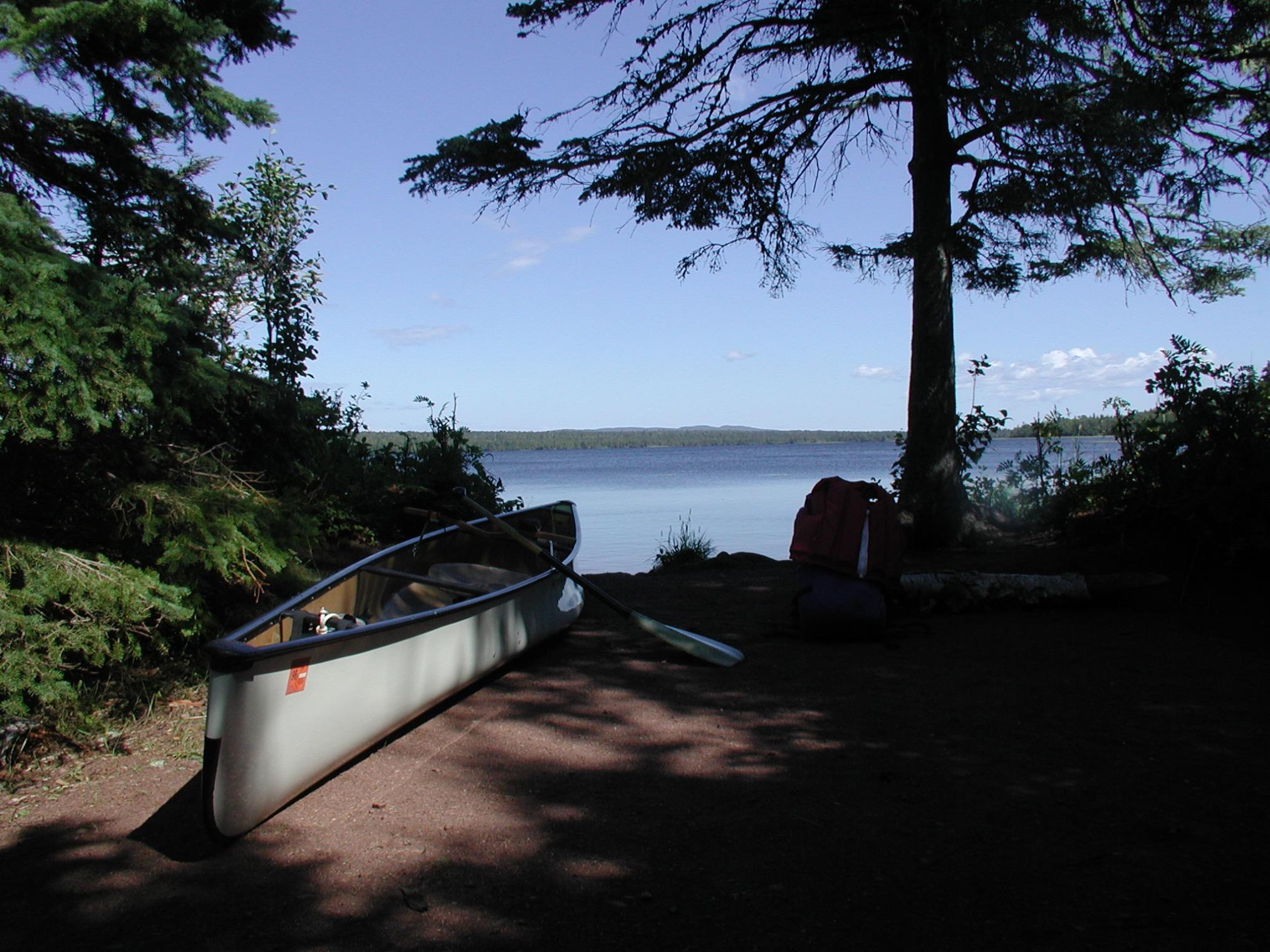
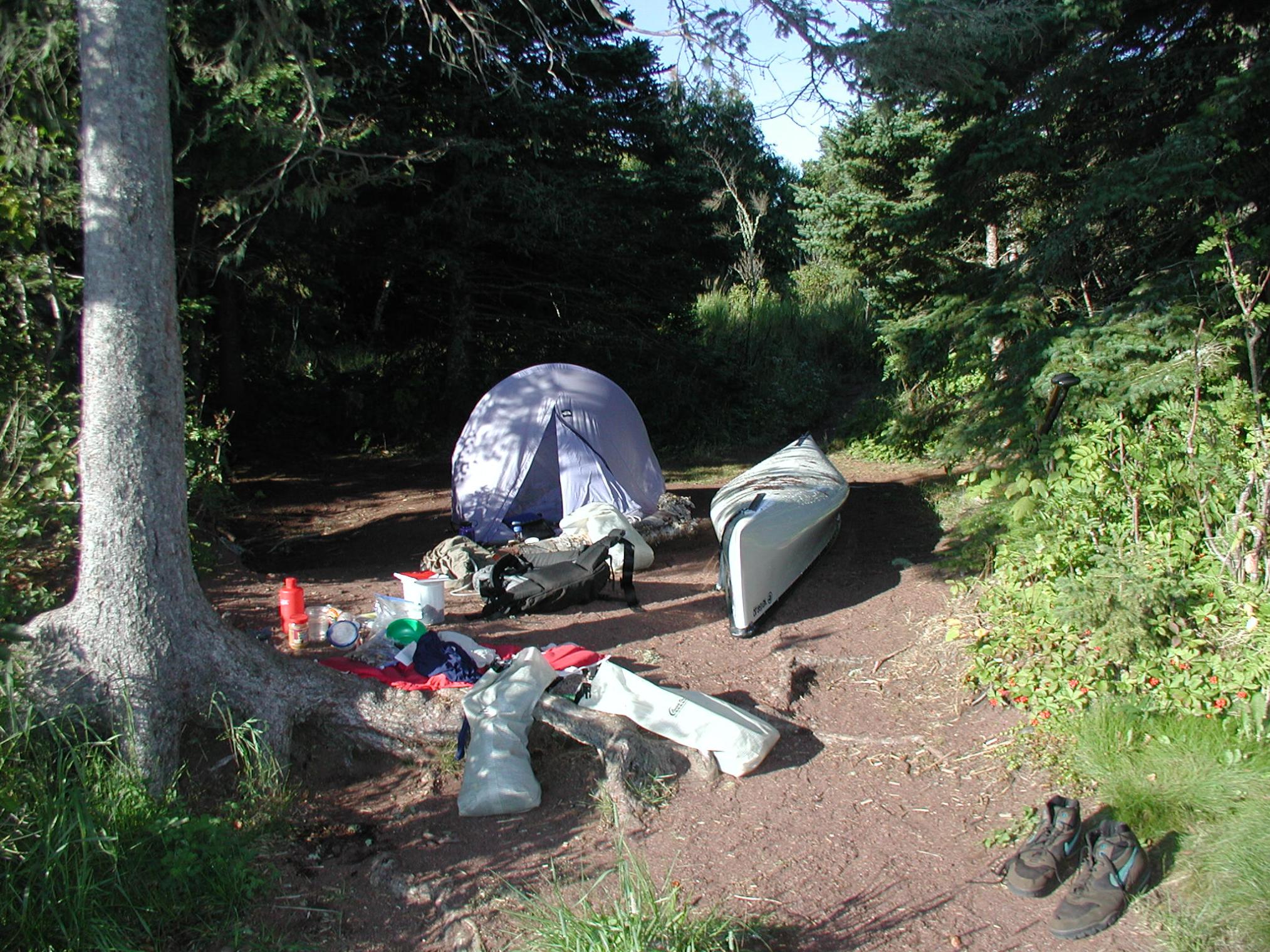


|
01/20/2018 09:43AM |
|
01/26/2018 12:51PM |
Rivermagic: "Yes from all accounts it appears the Advantage is some faster than the Magic, so my question is to what is this attributed to given the specs are so similar especially given the thinner waterline of the Magic. I realize this is about hull design and trying to learn and make sense of it. Looking at the numbers clearly does not tell the whole story."
I like to build canoes and the last half dozen I've designed myself. The software allows me to calculate how much resistance a hull has as it moves through the water. I won't say I understand the nuances of hull design but I've played around a lot and have been tickled pink with every boat I've designed. One thing I've stopped doing is trying to compare manufacturer specs and extrapolate how fast a canoe will be. There are so many small variables that all add up to make a small difference that it's impossible to point to one thing.
It's also shown me just how small the speed differences are in the 3-4.5 mph range for canoes in the same ball park spec-wise. As you tweak a hull for maximum speed you see it at the top end (5.5+mph) rather than normal cruising speeds. Actually you'll often see cruising speeds go down a little.
Alan
|
01/25/2018 10:05AM |
butthead
|
01/25/2018 12:17PM |
|
01/25/2018 01:26PM |

butthead
|
07/28/2017 10:17AM |
quote nlong: "
If I'm looking for a good workout, I can average 6mph for an hour strait in my 16'8" kevlar QCC600X and burst speeds of 8.5mph on flat water.......
My surf ski is 19.5' long and I can average closer to 6.5 mph with good effort, but I hate the seating position in it. Looking to eventually replace it with an Epic V10L."
That puts you well above the technique and conditioning of the average paddler. I had a QCC600x when I got into racing. Thought I was pretty fast until we showed up at a race in Minneapolis and got pummeled by a bunch of solo canoes. At that point I could average 5.3mph for a 6 mile course and thought I had the boat pretty well maxed out.
So I bought a West side boat shop Thunderbolt (about 21' long/18" wide) thinking it would be the easy answer. At first I was thrilled with how fast I could sprint the boat and how easy I could achieve higher speeds but over 6 miles my average speed was still only 5.5mph.
After 1 1/2 years of training pretty hard my average speed in the Thunderbolt was up to 6.7mph on a really good day and the QCC600 I thought I had maxed out at 5.3mph could suddenly average just over 6. At that point I wasn't even a middle of the pack racer. The next summer I built myself a house and didn't do any racing or training. Was never able to get back into it after that although I still enjoy paddling hard.
Every time I'd sprint up to 8mph in the Thunderbolt it amazed me that there are paddlers who can maintain that level of output for miles. That's some serious effort required.
Alan
|
07/22/2017 11:27PM |
|
07/21/2017 12:36PM |
quote Pinetree: "quote AmarilloJim: "Been wanting to take my GPS out with my canoes for comparison. Finally did it yesterday and here are the numbers.
I paddled both with a kayak paddle and the lake was glass.
Bell Magic
cruising speed 4.75mph
hard paddle 5.8mph
max 6.1mph
Osagian 15' aluminum battle wagon(standard flat bottom aluminum, minimal rocker, 35"beam)
cruising speed 3.75mph
hard paddle 4.5mph
max 5.0mph
"
Awesome speed,it would be interesting how long you could hold the Bell magic speeds for?
"
This morning I paddled a magic for an out&back on the Mississippi and sustained 5.1 mph for 10miles. It was a fasting workout, but the best I've clocked this year. Headwind did pick up for the return trip so I think I could be a little faster :). I've never tried an instantaneous max speed.

|
07/21/2017 03:05PM |
When I'm out of racing shape but in good tripping shape 3 miles going all out in my old Bell Magic would average about 5.3 MPH. The same 3 miles in a racing C-1 (j-180) would have an average speed of 5.4mph. The fast boat starts out fast at the initial sprint and feels easy for the first half mile or so. Then you start to tire and speed begins to taper off.
With the Magic I could sprint to 6.3 but in J-180 I could push to 7mph.
The better your conditioning the more speed you can get out of a faster boat but the speed doesn't come free. Regular paddling won't get you there.
There's nothing all that special about a Magic's speed. I've had a few different solos and against similarly shaped boats it's not really any faster than any of them in a sprint or a cruise. I've also paddled a Savage River Blackwater expecting a really fast boat but for me it wasn't really any faster than a Magic or my cedar strip Barracuda. No doubt for a strong paddler it would be a faster boat but for a regular paddler the difference is slight.
Although sprint speeds can be misleading in terms of all day speed I don't discount them. For upstream travel an extra .2mph can be the difference in paddling up a rapid or portaging.
Alan
|
07/21/2017 03:27PM |
|
04/02/2018 11:04PM |
I paddle a Prism. I hit and switch my way from lake to lake. No GPS. No measuring. Nope, not for me. Just take my time and paddle and portage all day.
I guess sort of how I stumble through life. Not the brightest bulb but I keep on burning after all these years.
|
04/03/2018 08:35AM |
GraniteCliffs: "I just read this whole thread. My head is swimming with numbers, formulas and perspectives. None of it makes much sense to a simpleton like me.
I paddle a Prism. I hit and switch my way from lake to lake. No GPS. No measuring. Nope, not for me. Just take my time and paddle and portage all day.
I guess sort of how I stumble through life. Not the brightest bulb but I keep on burning after all these years."
Wow Granite really like that post, beautifully poetic.
My paddling life, right now, is all about convenience, very quick outings locally and an occasional race. If someone is interested, I agree to do the long race here in Missouri. The Missouri River is my backyard and I love being on it. My passion is not equally shared by my life mate, so my time canoeing is best done "now and again" and ideally after work when it does not get in the way of other commitments. When as a family we boat, I leave the GPS at home, the Grumman acting as a sag wagon behind the sailboat. Life is grand, I too like stumbling through it.
|
04/10/2018 10:15AM |
Rivermagic: "Average speed from 6.7 mile race was 4.56 mph in Advantage. Winning solos canoe was a USCA C1 at 5.02 mph. AmorilloJim started the post in a Magic using a double blade. "
Nice work. That's not too bad for starting out in the Advantage. I'm surprised the winning speed in a C1 was only 5mph. That's pretty slow unless you guys were fighting current. I could have done better than that in my Magic when I was in better shape (and I wasn't very good). First time I ever raced my kayak against C1 boats I averaged 5mph and got absolutely trounced.
I'm learning to appreciate how good those numbers are.
Yeah, it's pretty shocking how much effort is required for a small gain in speed. Big eye opener for me was going to nationals and watching the top three C1 paddlers come to the line neck and neck. They were all paddling different boats and different paddles, all of which were touted as offering a speed advantage, but after 18 miles there was only a few yards separating all three. But they were a long way ahead of the next pack (who were no slouches) who were paddling the same boats and paddles as the winners. Makes you realize how much of it is the paddler rather than the equipment.
Alan
|
02/16/2018 09:03AM |
Thanks for all the advice. Trolling Craigslist I saw an exciting post. Like new 2 year old Wenonah Advantage UL Kevlar. I drove 4 hours leaving work an hour early arriving there at 9:30pm getting back to sisters home at 3:00am, at work now in same clothes as last night, unshaven and very EXCITED!! I am very blessed. I told him he could sell for significantly more, he was not interested and just wanted to find someone who can appreciate the canoe. I CAN! I'll post my thoughts after getting to actually paddle the canoe.
|
09/14/2016 01:36PM |
|
09/14/2016 08:53PM |
quote yellowcanoe: "quote PortageKeeper: "quote billconner: "Man, I go tripping to relax and get away from the rat race and last thing on my mind is canoe speed and going fast."
but I do care about efficiency and the speed usually equates to how efficient the hull is."
Nope. The efficiency is how well you plant and recover your paddle and how well your cadence is matched to the paddle design and how well you are matched to the boat.
Size matters.. Little short armed person with less strength needs less boat to keep up with bigger stronger paddler in bigger boat.
That is the underlying principle why Dave Curtis builds multiple size boats at Hemlock Boat Works. He understands physics and I don't see any interest of that here."
Please explain how hull efficiency does not equate to speed because my brain is hurting right now.
|
09/14/2016 09:33PM |
quote AmarilloJim: "Been wanting to take my GPS out with my canoes for comparison. Finally did it yesterday and here are the numbers.
I paddled both with a kayak paddle and the lake was glass.
Bell Magic
cruising speed 4.75mph
hard paddle 5.8mph
max 6.1mph
Osagian 15' aluminum battle wagon(standard flat bottom aluminum, minimal rocker, 35"beam)
cruising speed 3.75mph
hard paddle 4.5mph
max 5.0mph
"
Awesome speed,it would be interesting how long you could hold the Bell magic speeds for?
|
09/14/2016 11:26AM |
|
09/14/2016 11:34AM |
|
09/14/2016 12:32PM |
butthead
|
09/14/2016 01:38PM |
quote billconner: "Man, I go tripping to relax and get away from the rat race and last thing on my mind is canoe speed and going fast."
Generally, I'm with ya, Bill. Sweet and slow is the way to go, plus it lets me sneaks up on the fishies. However, last summer i paddled across England and the stern person in the other boat was 85 and kept passing my canoe. So, in the evening, I'd watch youtube videos on paddling technique and when I started twisting my waist, the octogenarian stopped passing us. Core = More!
|
09/15/2016 07:33AM |
|
09/15/2016 07:45AM |
quote missmolly: "quote Savage Voyageur: "quote yellowcanoe: "quote PortageKeeper: "quote billconner: "Man, I go tripping to relax and get away from the rat race and last thing on my mind is canoe speed and going fast."
but I do care about efficiency and the speed usually equates to how efficient the hull is."
Nope. The efficiency is how well you plant and recover your paddle and how well your cadence is matched to the paddle design and how well you are matched to the boat.
Size matters.. Little short armed person with less strength needs less boat to keep up with bigger stronger paddler in bigger boat.
That is the underlying principle why Dave Curtis builds multiple size boats at Hemlock Boat Works. He understands physics and I don't see any interest of that here."
Please explain how hull efficiency does not equate to speed because my brain is hurting right now.
"
It's easy breezy:
v = v0 + at
x = x0 + v0t + ½at2
v2 = v02 + 2a(x ? x0)
v? = ½(v + v0)
and
a? = ?v
?t
a = dv
dt
and
v? = ?s
?t
v = ds
dt
Glad I could help!
"
They said there would be no math.
|
09/15/2016 07:52AM |
|
09/15/2016 08:05AM |
|
09/14/2016 05:26PM |
quote PortageKeeper: "quote billconner: "Man, I go tripping to relax and get away from the rat race and last thing on my mind is canoe speed and going fast."
but I do care about efficiency and the speed usually equates to how efficient the hull is."
Nope. The efficiency is how well you plant and recover your paddle and how well your cadence is matched to the paddle design and how well you are matched to the boat.
Size matters.. Little short armed person with less strength needs less boat to keep up with bigger stronger paddler in bigger boat.
That is the underlying principle why Dave Curtis builds multiple size boats at Hemlock Boat Works. He understands physics and I don't see any interest of that here.
|
09/15/2016 07:26AM |
quote Savage Voyageur: "quote yellowcanoe: "quote PortageKeeper: "quote billconner: "Man, I go tripping to relax and get away from the rat race and last thing on my mind is canoe speed and going fast."
but I do care about efficiency and the speed usually equates to how efficient the hull is."
Nope. The efficiency is how well you plant and recover your paddle and how well your cadence is matched to the paddle design and how well you are matched to the boat.
Size matters.. Little short armed person with less strength needs less boat to keep up with bigger stronger paddler in bigger boat.
That is the underlying principle why Dave Curtis builds multiple size boats at Hemlock Boat Works. He understands physics and I don't see any interest of that here."
Please explain how hull efficiency does not equate to speed because my brain is hurting right now.
"
It's easy breezy:
v = v0 + at
x = x0 + v0t + ½at2
v2 = v02 + 2a(x ? x0)
v? = ½(v + v0)
and
a? = ?v
?t
a = dv
dt
and
v? = ?s
?t
v = ds
dt
Glad I could help!
|
09/15/2016 08:43AM |
quote Savage Voyageur: "quote missmolly: "quote Savage Voyageur: "quote yellowcanoe: "quote PortageKeeper: "quote billconner: "Man, I go tripping to relax and get away from the rat race and last thing on my mind is canoe speed and going fast."
but I do care about efficiency and the speed usually equates to how efficient the hull is."
Nope. The efficiency is how well you plant and recover your paddle and how well your cadence is matched to the paddle design and how well you are matched to the boat.
Size matters.. Little short armed person with less strength needs less boat to keep up with bigger stronger paddler in bigger boat.
That is the underlying principle why Dave Curtis builds multiple size boats at Hemlock Boat Works. He understands physics and I don't see any interest of that here."
Please explain how hull efficiency does not equate to speed because my brain is hurting right now.
"
It's easy breezy:
v = v0 + at
x = x0 + v0t + ½at2
v2 = v02 + 2a(x ? x0)
v? = ½(v + v0)
and
a? = ?v
?t
a = dv
dt
and
v? = ?s
?t
v = ds
dt
Glad I could help!
"
They said there would be no math. "
"No math" is life's big lie.
|
09/15/2016 08:44AM |
quote AmarilloJim: "I'm sure that eased his pain!"
Ha! Of course, those equations (acceleration and velocity) are Greek to me too, but I can copy and paste!
|
09/15/2016 09:43AM |
|
09/15/2016 12:42PM |
quote PortageKeeper: "My Magic has more glide than some boats which means less loss of speed between paddle strokes, which means less paddle strokes per day, which means that I am less worn out by the end of the day, which (to me) means more efficient. No math needed for me to see this."
I call that "the lazy way" and do much of it in my Advantage!
butthead
|
01/11/2018 03:38PM |
|
01/11/2018 02:53PM |
Thanks
|
01/16/2018 11:39AM |
if I could only get 2-3 more hits per side and another 1 mph.
You might pick up a couple hits per side but you won't gain anything close to 1mph. Over the course of a day I think the best you could hope for would be a couple tenths.
I paddled the Blackwater with a GPS briefly (20 minutes) and while I thought it was a really nice boat I didn't think it was appreciably faster than my Magic. The stronger paddler you are the more the speed differences in them will become apparent but as trippers we generally don't get near the performance out of them that racers do; especially since we're paddling them loaded.
If fitness paddling and racing are why you want speed then looking for a boat with more speed potential is good. If you're mainly worried about covering more ground when tripping don't sweat it and instead work on ways to break camp faster cut down portaging time.
Alan
|
01/16/2018 12:58PM |
The same applies to a larger volume boat that allows you to travel in rough water where a faster/narrow hull would leave you wind bound for the day.
I still want a boat to be as fast and efficient as possible but my hulls seem to be growing in volume.
Alan
|
01/19/2018 04:09PM |
butthead
|
01/16/2018 12:26PM |
|
01/16/2018 01:40PM |
Alan Gage: "The same applies to a larger volume boat that allows you to travel in rough water where a faster/narrow hull would leave you wind bound for the day.
I still want a boat to be as fast and efficient as possible but my hulls seem to be growing in volume.
Alan"
Another reason why I switched from a Magic to a SRQ16
|
01/16/2018 02:38PM |
|
01/16/2018 09:30PM |
|
01/16/2018 10:31PM |
|
01/17/2018 11:44AM |
Relying on one in a canoe race would be similar to j-stroking. So, combining a rudder and sit and switch seems like sort of an odd approach.
|
01/17/2018 11:51AM |
Maybe solo I like a kayak paddle it is such a straight line paddling and adds so much speed and control if you desire.
The true single paddle paddlers is a true art in efficiency which I do not have.
|
01/17/2018 12:11PM |
|
01/17/2018 04:48PM |
MagicPaddler:
I found that with the rudder down and cranked as far as it would go trying to turn into the wind and paddling on only on the side to help turn into the wind the best I could do was turn broadside to the wind. I would lift the rudder and with 5 or 6 strokes I could turn into the wind. So the canoe was loaded so it was easy to handle without a rudder."
With a beam wind and a level trimmed boat, the wind will tend to turn you into the wind as it pushes on the stern. With the rudder down, that may have tended to prevent the stern from moving. When you pulled the rudder up, the stern could move, and thus it was easy to move the boat into the wind. If you have trouble turning into the wind, just weight the bow more. I paddle solo, and have a day pack forward within reach of of the paddle--I push it forward, and maybe pull my main (aft) pack forward. And then a sliding seat helps.
|
07/27/2017 07:46AM |
I own the canoes I own. I paddle the way I paddle and I'm not as strong as I used to be so I get there when I get there.
But it is a fascinating conversation.
|
07/26/2017 10:45AM |
If I'm looking for a good workout, I can average 6mph for an hour strait in my 16'8" kevlar QCC600X and burst speeds of 8.5mph on flat water. I've topped out at 12mph for short bursts with my flatwater K1, but cannot average the speeds of the olympic 200m racers that do 13mph, and that boat is tippy as hell.
I've actually taken my QCC600X on a 6 day trip in the BWCA. Portaging was a bit of a pain and the gelcoat got a bit beat up to where I had to do some repairs after the trip, but it was joy to paddle bigger lakes like when I hit Little Sag, Kek, Ogish, and then only taking an hour to get the 6 miles across Seagull.
I now take my 12' Perception Tribute on my solo trips. It's 6lbs lighter than the sea kayak at 40lbs, and i just strap a 75L SeaLine boundary pack to the rear deck and it paddles great. Cruise speed isn't as fast, but it is way easier to portage and I'm not afraid to run it up on rocks.
My surf ski is 19.5' long and I can average closer to 6.5 mph with good effort, but I hate the seating position in it. Looking to eventually replace it with an Epic V10L.
|
01/22/2018 04:02PM |
|
01/25/2018 09:10AM |
|
04/02/2018 10:21AM |
|
04/09/2018 08:55AM |
|
04/12/2018 11:43AM |
Looking back at past results for this race the fastest C1 time is just about 7 mph. Usually, the average winning speed is about 5.6-5.8. Current is about .5 mph, but it's a double loop so you get the advantage on the way back, with the exception of the home stretch. I'm planning on using my GPS more and practicing at 5.5 and working on my stamina. 'tis fun!